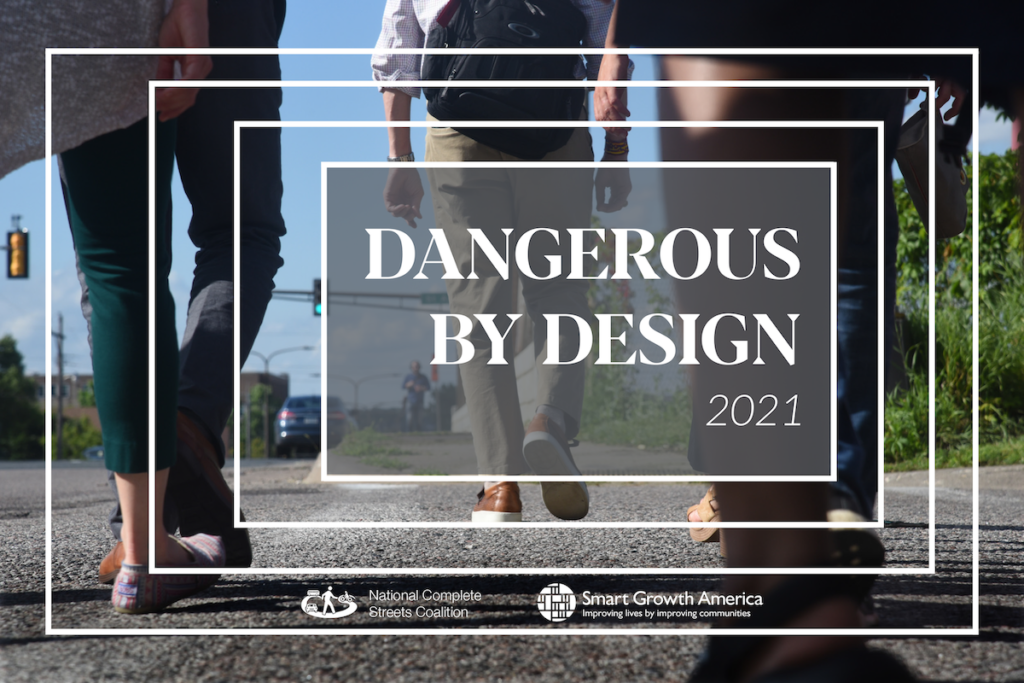Dangerous By Design 2021
Learn about Dangerous by Design 2021
Watch our experts go in-depth on the findings and rankings, and hear from a few special guests as well in the recorded webinar. You can also help promote this report—visit this folder of graphics, images, and social media prompts to help spread the word about Dangerous by Design 2021.

The number of people struck and killed by drivers nationwide while walking increased by an astonishing 45 percent over the last decade (2010-2019).
The four most recent years on record (2016-2019) are the most deadly years for pedestrian deaths since 1990. During this ten-year period, 53,435 people were hit and killed by drivers.
In 2019, the 6,237 people killed is the equivalent of more than 17 people dying per day.
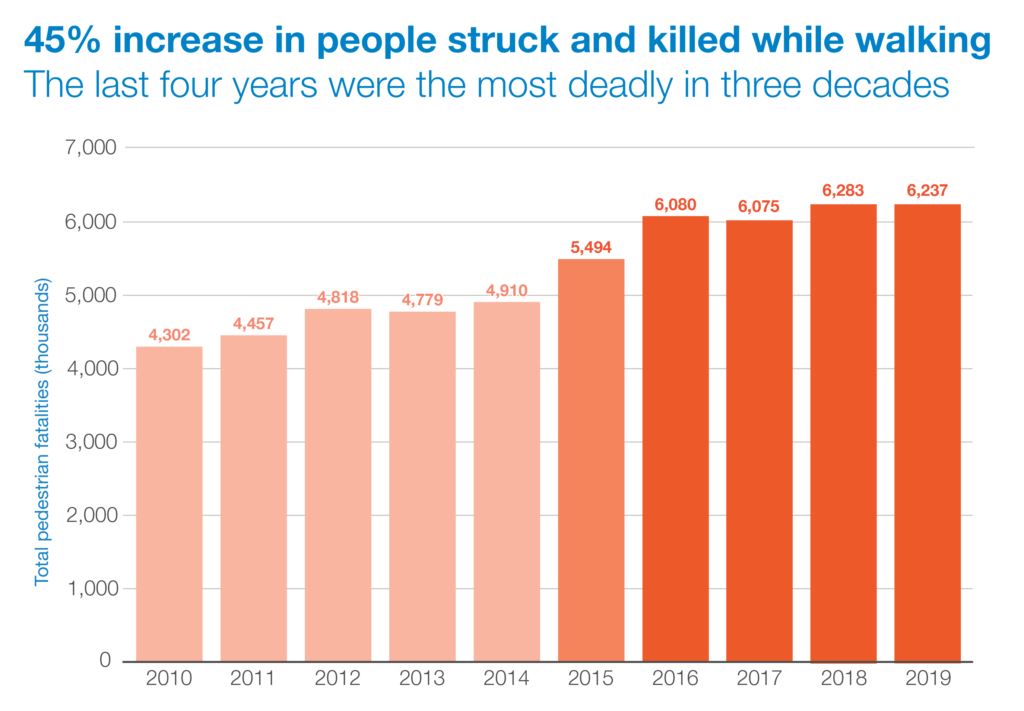
If these statements feel familiar, it’s because they are, painfully so. It has been more than a decade since the first edition of Dangerous by Design, and this problem has only gotten worse. Dangerous by Design 2021 takes a closer look at this alarming epidemic.

The risk is not evenly distributed
Older adults, people of color, and people walking in low-income communities are disproportionately represented in fatal crashes involving people walking—even after controlling for differences in population size and walking rates.
Although people of all ages, races, ethnicities, and income levels suffer the consequences of dangerous street design, some neighborhoods and groups of people bear a larger share of the burden than others, which may contribute to the indifference of many policymakers to this astonishing increase. From 2010-2019, Black people were struck and killed by drivers at a 82 percent higher rate than White, non-Hispanic Americans. For American Indian and Alaska Native people, that disparity climbs to 221 percent.
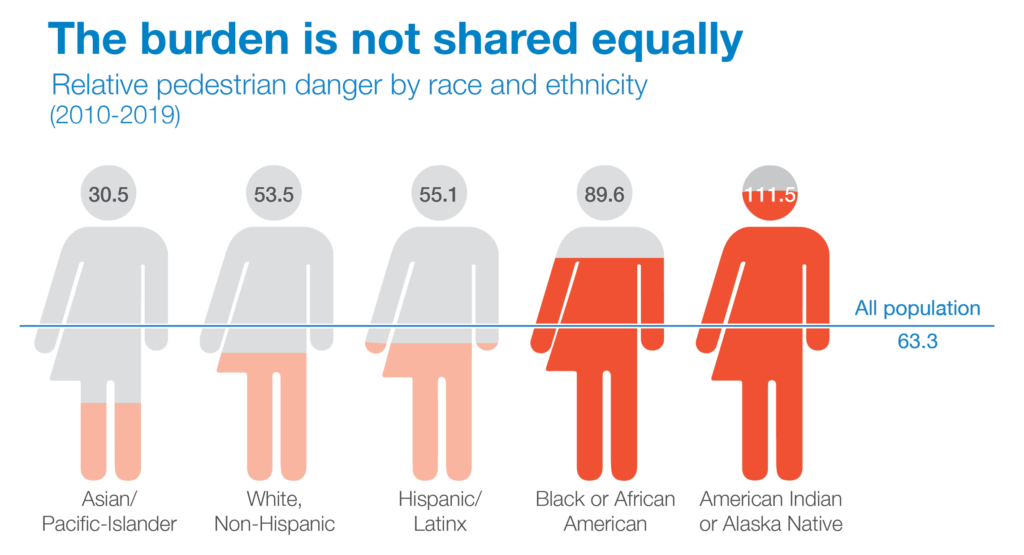
People age 50 and up, and especially people age 75 and older, are overrepresented in these deaths. These age groups are more likely to experience challenges seeing, hearing, or moving, and if these trends are any indication, we are not devoting nearly enough attention to the unique needs of older adults when we design our streets.
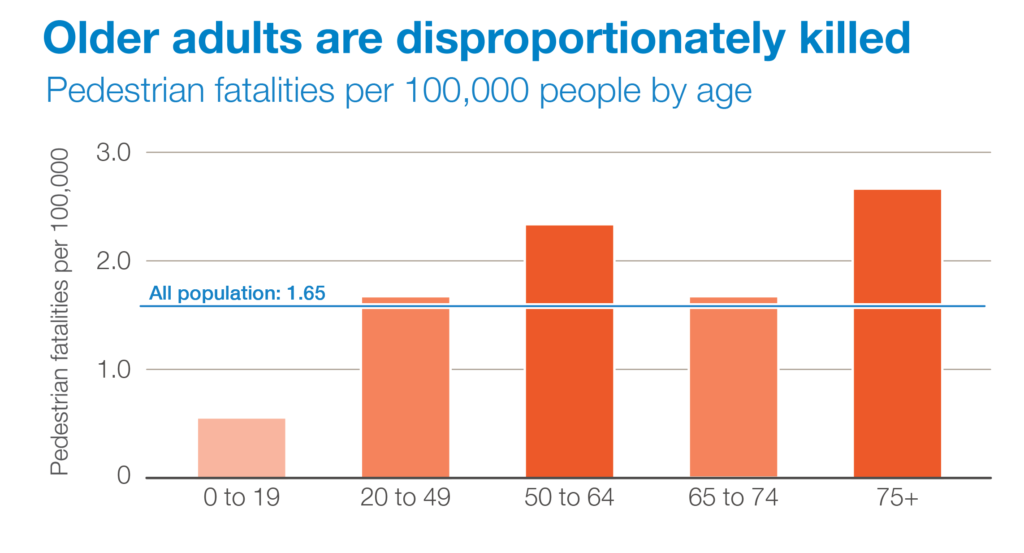
People walking in lower-income neighborhoods are also killed far more often. The lower a metro area’s median household income, the more dangerous its streets are likely to be for people walking.
The fatality rate in the lowest income neighborhoods was nearly twice that of middle income census tracts (in median household income) and almost three times that of higher-come neighborhoods. This is unsurprising, given that low-income communities are significantly less likely than higher-income communities to have sidewalks, marked crosswalks, and street design to support safer, slower speeds.
Protecting the safety of all people who use the street, especially those most vulnerable to being struck and killed, needs to be a higher priority for policymakers, and this priority must be reflected in the decisions we make about how to fund, design, operate, maintain, and measure the success of our roads.
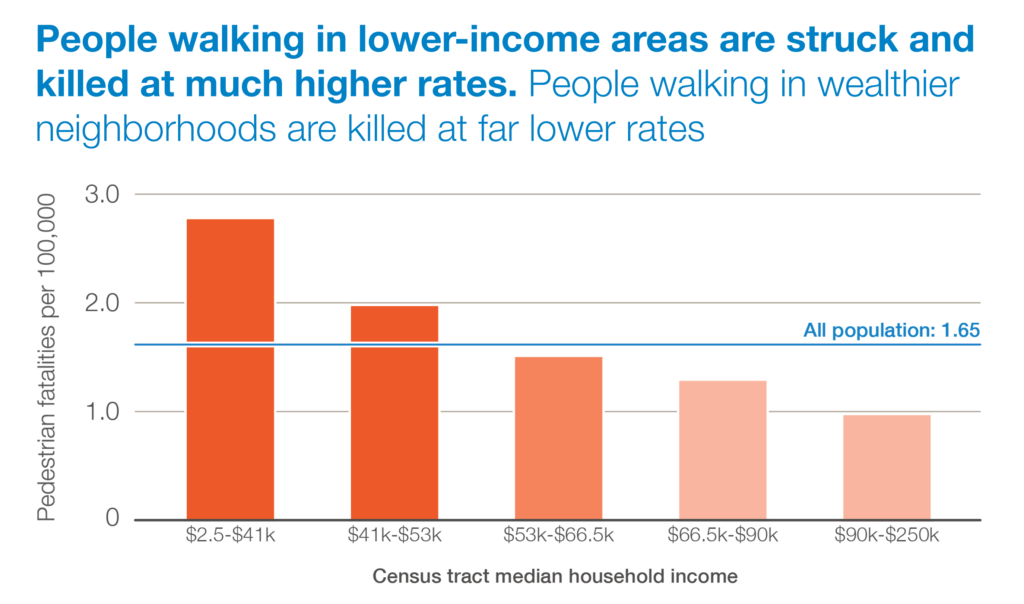
To reverse these trends and save lives, we need to protect all users of the transportation system through our policies, programs, and funding, while prioritizing the safety of those who are most at risk.
Why is this happening?
In a word, because state and local transportation agencies place a higher value on speed (and avoiding delay) than they do on safety. It’s simply not possible to prioritize both. When faced with decisions that would elevate and prioritize safety for people walking but increase delay for vehicles, the decision-makers’ true priorities are laid bare.
Many states and localities have spent the last ten years focusing on enforcement, running ineffectual education campaigns, or blaming the victims of these crashes, while ignoring or actively distracting people from the role of roadway design in these deaths. States and localities must stop deploying the same playbook and expecting this trend to change—they need a fundamentally different approach to the problem. They need to acknowledge that their approach to building and operating streets and roads contributes to these deaths.
Where are the most dangerous places?
Dangerous by Design ranks states and metropolitan areas around the country using our “Pedestrian Danger Index”, or PDI, which measures how deadly it is for people to walk based on the number of people struck and killed by drivers while walking, controlling for the number of people and the share of people who walk to work as a proxy for overall walking in an area. This report includes deaths that occurred between 2010 and 2019 from the Fatality Analysis Reporting System (FARS), a national database of all fatal traffic crashes. See the state/metro rankings tabs for the full dataset of all metros and states.
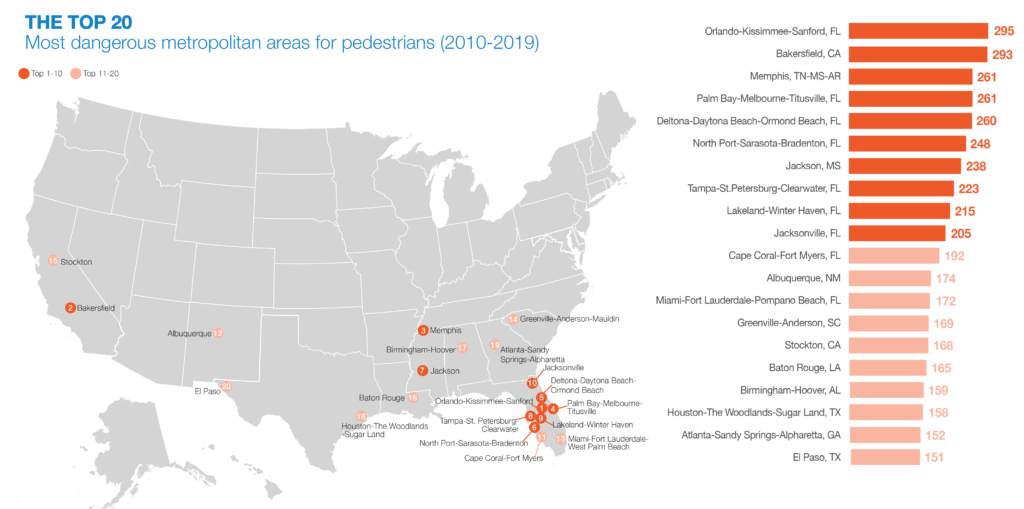
| Rank | Metropolitan statistical area | Pedestrian fatalities (2010-2019) | Average annual pedestrian fatalities per 100,000 (2010-2019) | Pedestrian Danger Index |
|---|---|---|---|---|
| 1 | Orlando-Kissimmee-Sanford, FL | 740 | 3 | 295 |
| 2 | Bakersfield, CA | 260 | 2.9 | 293 |
| 3 | Memphis, TN-MS-AR | 350 | 2.6 | 261 |
| 4 | Palm Bay-Melbourne-Titusville, FL | 168 | 2.9 | 260.9 |
| 5 | Deltona-Daytona Beach-Ormond Beach, FL | 235 | 3.6 | 260 |
| 6 | North Port-Sarasota-Bradenton, FL | 199 | 2.5 | 248 |
| 7 | Jackson, MS | 128 | 2.1 | 237.8 |
| 8 | Tampa-St. Petersburg-Clearwater, FL | 968 | 3.1 | 222.9 |
| 9 | Lakeland-Winter Haven, FL | 162 | 2.4 | 214.6 |
| 10 | Jacksonville, FL | 462 | 3.1 | 204.7 |
| 11 | Cape Coral-Fort Myers, FL | 170 | 2.3 | 192.5 |
| 12 | Albuquerque, NM | 270 | 3 | 174.1 |
| 13 | Miami-Fort Lauderdale-West Palm Beach, FL | 1,675 | 2.8 | 171.9 |
| 14 | Greenville-Anderson-Mauldin, SC | 212 | 2.4 | 169.3 |
| 15 | Stockton-Lodi, CA | 187 | 2.5 | 168 |
| 16 | Baton Rouge, LA | 211 | 2.5 | 164.7 |
| 17 | Birmingham-Hoover, AL | 190 | 1.8 | 159.1 |
| 18 | Houston-The Woodlands-Sugar Land, TX | 1,298 | 1.9 | 157.5 |
| 19 | Atlanta-Sandy Springs-Roswell, GA | 1,160 | 2 | 152.3 |
| 20 | El Paso, TX | 215 | 2.6 | 150.6 |
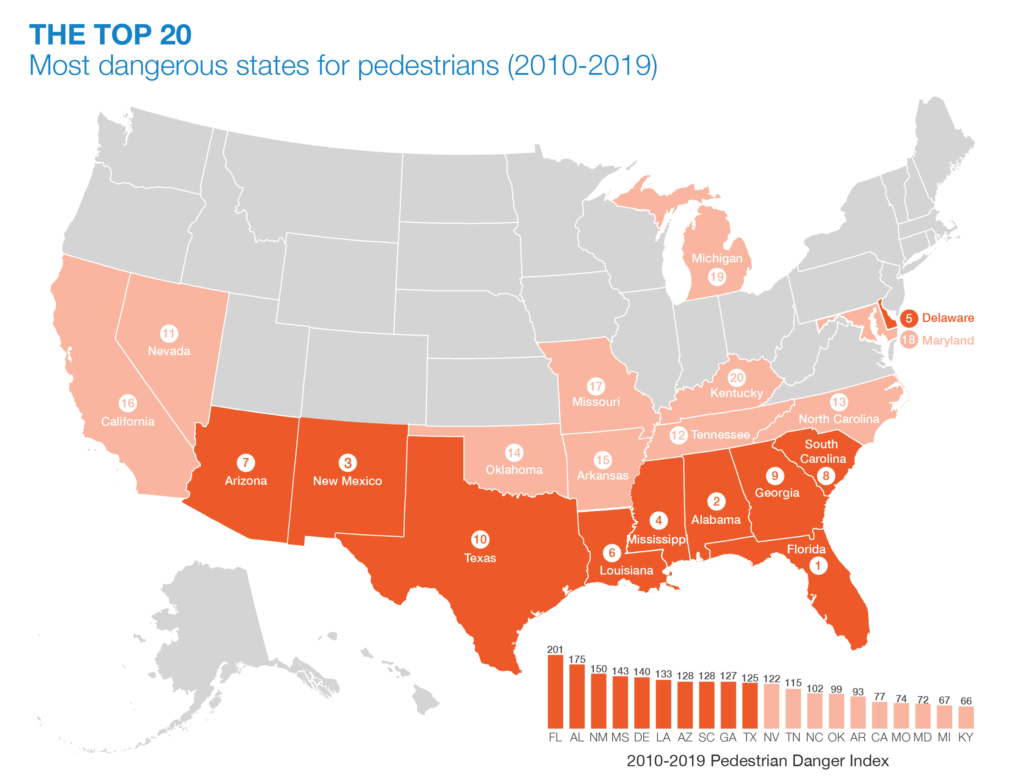
| Rank | State | Pedestrian fatalities (2010-2019 | Average annual pedestrian fatalities per 100,000 (2010-2019) | Pedestrian Danger Index |
|---|---|---|---|---|
| 1 | Florida | 5,893 | 2.8 | 201.4 |
| 2 | Alabama | 936 | 1.9 | 174.6 |
| 3 | New Mexico | 626 | 3 | 149.5 |
| 4 | Mississippi | 596 | 2 | 142.9 |
| 5 | Delaware | 269 | 2.8 | 140.5 |
| 6 | Louisiana | 1,118 | 2.4 | 133.3 |
| 7 | Arizona | 1,710 | 2.4 | 127.9 |
| 8 | South Carolina | 1,280 | 2.6 | 127.5 |
| 9 | Georgia | 1,980 | 1.9 | 126.7 |
| 10 | Texas | 5,308 | 1.9 | 125.3 |
| 11 | Nevada | 651 | 2.2 | 121.7 |
| 12 | Tennessee | 1,008 | 1.5 | 115.4 |
| 13 | North Carolina | 1,890 | 1.8 | 102.2 |
| 14 | Oklahoma | 662 | 1.7 | 98.8 |
| 15 | Arkansas | 473 | 1.6 | 92.9 |
| 16 | California | 7,891 | 2 | 77.3 |
| 17 | Missouri | 852 | 1.4 | 73.7 |
| 18 | Maryland | 1,083 | 1.8 | 72 |
| 19 | Michigan | 1,460 | 1.5 | 66.8 |
| National Average | 53,435 | 1.6 | 63.3 |
What can and should be done
Our federal government needs to take the lead on prioritizing safer streets. Federal dollars and policies helped create these unsafe streets in the first place. And federal funds, policies, and guidance have a significant role to play in fixing these streets and in designing the streets we’ll build tomorrow. Click the TAKE ACTION tab above for more specific actions, including a way to send a message to your representatives about the Complete Streets Act.
We call on Congress to adopt the Complete Streets Act of 2021 that requires state departments of transportation (DOTs) and metropolitan planning organizations (MPOs) to consistently plan for all people who use the street, including the most vulnerable users.
We call on state DOTs and MPOs to put people first and give their organizations the tools and training they need to create transportation networks that serve all users.
We call on the over 1,500 communities that have adopted a Complete Streets policy to turn their vision into practice and implementation.
And we call on you to demand safer streets from the elected officials in your communities.
Where are the most dangerous streets near you?
This interactive map plots every pedestrian fatality from 2008-2019. Zoom in and drag, or search for any U.S. address (or city/state) by clicking on the magnifying glass on the left side of the map. You can also use the other tools in the toolbar with the search button to draw a shape around a particular area to isolate the deaths in a specific area. Problems viewing the map? View it in a new page here. If the map appears small on your desktop/laptop, click the second icon from the right on the bottom of the map to convert to a larger desktop view.
Go a little deeper into the data with this more sophisticated look. You can filter by age, race/ethnicity, state and other criteria, and then see a year-over-year chart of fatalities by those filters below the map. Problems with the map? View it in a new page.
These maps were generated using data from the Fatality Analysis Reporting System, provided by the National Highway Transportation Safety Administration. *A total of 564 fatalities from 2008-2019 were excluded due to poor location data.
Metro-area rankings and data
This table shows the Pedestrian Danger Index (PDI) and other fatality statistics for each of the 100 largest metro areas (defined by the U.S. Census Bureau) in the country.
- The higher a metro area’s PDI, the more dangerous it is for people walking.
- Tables are sortable by any column, but default to the highest PDI (most dangerous) first.
- These table are also available in the appendix of the full report.
| Rank | Metropolitan statistical area | Pedestrian fatalities (2010-2019) | Average annual pedestrian fatalities per 100,000 (2010-2019) | 2019 report PDI | 2021 report PDI | Change in PDI between last two reports |
|---|---|---|---|---|---|---|
| 1 | Orlando-Kissimmee-Sanford, FL | 740 | 3 | 313.3 | 295 | -18.3 |
| 2 | Bakersfield, CA | 260 | 2.9 | 217.7 | 293 | 75.3 |
| 3 | Memphis, TN-MS-AR | 350 | 2.6 | 184.2 | 261 | 76.8 |
| 4 | Palm Bay-Melbourne-Titusville, FL | 168 | 2.9 | 245 | 260.9 | 15.9 |
| 5 | Deltona-Daytona Beach-Ormond Beach, FL | 235 | 3.6 | 265.4 | 260 | -5.4 |
| 6 | North Port-Sarasota-Bradenton, FL | 199 | 2.5 | 234.6 | 248 | 13.5 |
| 7 | Jackson, MS | 128 | 2.1 | 192 | 237.8 | 45.8 |
| 8 | Tampa-St. Petersburg-Clearwater, FL | 968 | 3.1 | 204.7 | 222.9 | 18.2 |
| 9 | Lakeland-Winter Haven, FL | 162 | 2.4 | 230.9 | 214.6 | -16.4 |
| 10 | Jacksonville, FL | 462 | 3.1 | 226.2 | 204.7 | -21.5 |
| 11 | Cape Coral-Fort Myers, FL | 170 | 2.3 | 217 | 192.5 | -24.5 |
| 12 | Albuquerque, NM | 270 | 3 | 138.2 | 174.1 | 35.9 |
| 13 | Miami-Fort Lauderdale-West Palm Beach, FL | 1,675 | 2.8 | 153.5 | 171.9 | 18.4 |
| 14 | Greenville-Anderson-Mauldin, SC | 212 | 2.4 | 152.7 | 169.3 | 16.6 |
| 15 | Stockton-Lodi, CA | 187 | 2.5 | 105.5 | 168 | 62.5 |
| 16 | Baton Rouge, LA | 211 | 2.5 | 157.9 | 164.7 | 6.8 |
| 17 | Birmingham-Hoover, AL | 190 | 1.8 | 157 | 159.1 | 2.1 |
| 18 | Houston-The Woodlands-Sugar Land, TX | 1,298 | 1.9 | 130 | 157.5 | 27.5 |
| 19 | Atlanta-Sandy Springs-Roswell, GA | 1,160 | 2 | 127.9 | 152.3 | 24.5 |
| 20 | El Paso, TX | 215 | 2.6 | 98.6 | 150.6 | 52 |
| 21 | Fresno, CA | 235 | 2.4 | 127.7 | 149.4 | 21.7 |
| 22 | Las Vegas-Henderson-Paradise, NV | 485 | 2.2 | 128.8 | 148 | 19.2 |
| 23 | Riverside-San Bernardino-Ontario, CA | 1,078 | 2.4 | 115.6 | 147.5 | 31.9 |
| 24 | Phoenix-Mesa-Scottsdale, AZ | 1,042 | 2.2 | 130 | 146 | 16 |
| 25 | Little Rock-North Little Rock-Conway, AR | 139 | 1.9 | 135 | 145.4 | 10.4 |
| 26 | Tulsa, OK | 171 | 1.7 | 116.9 | 144.2 | 27.3 |
| 27 | McAllen-Edinburg-Mission, TX | 133 | 1.6 | 140.8 | 141.8 | 1 |
| 28 | San Antonio-New Braunfels, TX | 582 | 2.4 | 131.2 | 138.8 | 7.6 |
| 29 | Augusta-Richmond County, GA-SC | 122 | 2 | 134.4 | 135.3 | 1 |
| 30 | Greensboro-High Point, NC | 133 | 1.8 | 124.6 | 134.6 | 10 |
| 31 | Dallas-Fort Worth-Arlington, TX | 1,160 | 1.6 | 124.2 | 131.7 | 7.5 |
| 32 | Louisville/Jefferson County, KY-IN | 247 | 2 | 104.1 | 130.7 | 26.6 |
| 33 | Detroit-Warren-Dearborn, MI | 774 | 1.8 | 135.4 | 127.9 | -7.5 |
| 34 | Charlotte-Concord-Gastonia, NC-SC | 421 | 1.7 | 107.9 | 126.9 | 19.1 |
| 35 | Raleigh, NC | 182 | 1.4 | 114.2 | 124.6 | 10.4 |
| 36 | Sacramento--Roseville--Arden-Arcade, CA | 476 | 2.1 | 86.2 | 121.2 | 35 |
| 37 | Nashville-Davidson--Murfreesboro--Franklin, TN | 276 | 1.5 | 99.2 | 113.1 | 13.9 |
| 38 | Winston-Salem, NC | 98 | 1.5 | 97.1 | 113.1 | 15.9 |
| 39 | Oklahoma City, OK | 245 | 1.8 | 110.7 | 110.6 | -0.1 |
| 40 | Tucson, AZ | 240 | 2.3 | 86.1 | 106.4 | 20.3 |
| 41 | Charleston-North Charleston, SC | 188 | 2.4 | 87.3 | 105.7 | 18.3 |
| 42 | Kansas City, MO-KS | 258 | 1.2 | 86.9 | 100.8 | 13.9 |
| 43 | Knoxville, TN | 111 | 1.3 | 102.5 | 100 | -2.5 |
| 44 | Indianapolis-Carmel-Anderson, IN | 297 | 1.5 | 91.3 | 97.3 | 6 |
| 45 | St. Louis, MO-IL | 429 | 1.5 | 87.5 | 95.6 | 8.1 |
| 46 | Austin-Round Rock, TX | 360 | 1.7 | 91.8 | 94.4 | 2.7 |
| 47 | Richmond, VA | 193 | 1.5 | 77.2 | 89.4 | 12.2 |
| 48 | New Orleans-Metairie, LA | 268 | 2.1 | 89.6 | 87.9 | -1.7 |
| 49 | Los Angeles-Long Beach-Anaheim, CA | 2,717 | 2.1 | 76.4 | 85.4 | 9 |
| 50 | San Jose-Sunnyvale-Santa Clara, CA | 323 | 1.6 | 80.6 | 81 | 0.4 |
| 51 | Chattanooga, TN-GA | 69 | 1.2 | 55 | 77.5 | 22.5 |
| 52 | Salt Lake City, UT | 171 | 1.4 | 70.5 | 74.7 | 4.2 |
| 53 | Ogden-Clearfield, UT | 71 | 1.1 | 61.2 | 71.3 | 10.2 |
| 54 | Baltimore-Columbia-Towson, MD | 517 | 1.9 | 63.6 | 71.2 | 7.6 |
| 55 | San Diego-Carlsbad, CA | 676 | 2 | 64.5 | 70.3 | 5.9 |
| 56 | Wichita, KS | 68 | 1.1 | 70.7 | 62.9 | -7.7 |
| 57 | Denver-Aurora-Lakewood, CO | 395 | 1.4 | 58.2 | 62.3 | 4.1 |
| 58 | Oxnard-Thousand Oaks-Ventura, CA | 96 | 1.1 | 51 | 59.5 | 8.5 |
| 59 | Columbia, SC | 215 | 2.6 | 49.8 | 59.3 | 9.6 |
| 60 | Durham-Chapel Hill, NC | 88 | 1.4 | 58.3 | 58.3 | |
| 61 | Hartford-West Hartford-East Hartford, CT | 158 | 1.3 | 50 | 57 | 7 |
| 62 | Columbus, OH | 244 | 1.2 | 53.8 | 55.7 | 1.9 |
| 63 | Scranton--Wilkes-Barre--Hazleton, PA | 83 | 1.5 | 42.1 | 55.2 | 13.1 |
| 64 | Grand Rapids-Wyoming, MI | 121 | 1.1 | 51.4 | 54.3 | 2.9 |
| 65 | Toledo, OH | 83 | 1.3 | 49.6 | 53.8 | 4.2 |
| 66 | Akron, OH | 57 | 0.8 | 44.4 | 50.6 | 6.2 |
| 67 | Philadelphia-Camden-Wilmington, PA-NJ-DE-MD | 1,104 | 1.8 | 46.8 | 50.6 | 3.8 |
| 68 | Bridgeport-Stamford-Norwalk, CT | 119 | 1.3 | 39.6 | 50.4 | 10.8 |
| 69 | Milwaukee-Waukesha-West Allis, WI | 196 | 1.2 | 41.9 | 49.6 | 7.8 |
| 70 | Dayton, OH | 95 | 1.2 | 42.4 | 49.2 | 6.8 |
| 71 | Cincinnati, OH-KY-IN | 210 | 1 | 42.9 | 47.5 | 4.6 |
| 72 | Omaha-Council Bluffs, NE-IA | 75 | 0.8 | 36.1 | 47.1 | 11 |
| 73 | Harrisburg-Carlisle, PA | 77 | 1.4 | 41.7 | 46.6 | 4.9 |
| 74 | Boise City, ID | 56 | 0.8 | 36.1 | 46.5 | 10.4 |
| 75 | Allentown-Bethlehem-Easton, PA-NJ | 99 | 1.2 | 43.9 | 45.4 | 1.5 |
| 76 | Des Moines-West Des Moines, IA | 55 | 0.8 | 44.4 | 45 | 0.6 |
| 77 | Buffalo-Cheektowaga-Niagara Falls, NY | 125 | 1.1 | 44.2 | 44.4 | 0.2 |
| 78 | New Haven-Milford, CT | 133 | 1.6 | 38.1 | 44.3 | 6.2 |
| 79 | Portland-Vancouver-Hillsboro, OR-WA | 350 | 1.4 | 35.9 | 43.3 | 7.5 |
| 80 | Virginia Beach-Norfolk-Newport News, VA-NC | 239 | 1.4 | 41.3 | 41.2 | -0.1 |
| 81 | Washington-Arlington-Alexandria, DC-VA-MD-WV | 801 | 1.3 | 39.7 | 40.3 | 0.6 |
| 82 | Cleveland-Elyria, OH | 169 | 0.8 | 35.9 | 39.1 | 3.1 |
| 83 | Chicago-Naperville-Elgin, IL-IN-WI | 1,112 | 1.2 | 34.5 | 39 | 4.5 |
| 84 | Albany-Schenectady-Troy, NY | 111 | 1.3 | 34.6 | 38.2 | 3.6 |
| 85 | Rochester, NY | 120 | 1.1 | 29.1 | 36.1 | 7 |
| 86 | Urban Honolulu, HI | 189 | 1.9 | 30.6 | 34.9 | 4.3 |
| 87 | Providence-Warwick, RI-MA | 186 | 1.2 | 33.6 | 33.8 | 0.2 |
| 88 | Worcester, MA-CT | 104 | 1.1 | 33.3 | 33.3 | 0 |
| 89 | Syracuse, NY | 81 | 1.2 | 23.8 | 32.6 | 8.9 |
| 90 | San Francisco-Oakland-Hayward, CA | 687 | 1.5 | 33.5 | 32.4 | -1.1 |
| 91 | Minneapolis-St. Paul-Bloomington, MN-WI | 254 | 0.7 | 30.9 | 32.3 | 1.4 |
| 92 | Colorado Springs, CO | 75 | 1 | 23.5 | 29.7 | 6.2 |
| 93 | New York-Newark-Jersey City, NY-NJ-PA | 3,112 | 1.6 | 27.1 | 28.3 | 1.1 |
| 94 | Pittsburgh, PA | 217 | 0.9 | 27.3 | 28.2 | 0.9 |
| 95 | Seattle-Tacoma-Bellevue, WA | 408 | 1.1 | 26.5 | 26.9 | 0.4 |
| 96 | Springfield, MA | 86 | 1.2 | 24.7 | 26.7 | 2.1 |
| 97 | Boston-Cambridge-Newton, MA-NH | 469 | 1 | 19.6 | 19 | -0.6 |
| 98 | Poughkeepsie-Newburgh-Middletown, NY | 56 | 0.8 | 18.9 | 18.9 | |
| 99 | Madison, WI | 52 | 0.8 | 18 | 17.4 | -0.6 |
| 100 | Provo-Orem, UT | 40 | 0.7 | 17.3 | 14.8 | -2.6 |
| NR | Spokane-Spokane Valley, WA | 36.2 | NA | |||
| NR | Youngstown-Warren-Boardman, OH-PA | 67.2 | NA |
State rankings
In addition to metro areas, Dangerous by Design also examines statewide PDI. After that table, brief state reports provide yet another layer of state-level data.
This table below shows the PDI for all 50 states and the District of Columbia, as well as change since the last report
- More information on change in PDI since Dangerous by Design 2019 and other pieces of state-level data are available in the appendix of the full report.
| Rank | State | Pedestrian fatalities (2010-2019 | Average annual pedestrian fatalities per 100,000 (2010-2019) | 2019 report PDI | 2021 report PDI | Change in PDI between last two reports |
|---|---|---|---|---|---|---|
| 1 | Florida | 5,893 | 2.8 | 182 | 201.4 | 19.4 |
| 2 | Alabama | 936 | 1.9 | 145 | 174.6 | 29.6 |
| 3 | New Mexico | 626 | 3 | 117.3 | 149.5 | 32.2 |
| 4 | Mississippi | 596 | 2 | 122.7 | 142.9 | 20.2 |
| 5 | Delaware | 269 | 2.8 | 127.1 | 140.5 | 13.4 |
| 6 | Louisiana | 1,118 | 2.4 | 125 | 133.3 | 8.3 |
| 7 | Arizona | 1,710 | 2.4 | 111.5 | 127.9 | 16.4 |
| 8 | South Carolina | 1,280 | 2.6 | 107.7 | 127.5 | 19.8 |
| 9 | Georgia | 1,980 | 1.9 | 117.3 | 126.7 | 9.3 |
| 10 | Texas | 5,308 | 1.9 | 111.9 | 125.3 | 13.5 |
| 11 | Nevada | 651 | 2.2 | 101 | 121.7 | 20.7 |
| 12 | Tennessee | 1,008 | 1.5 | 100.8 | 115.4 | 14.6 |
| 13 | North Carolina | 1,890 | 1.8 | 98.3 | 102.2 | 3.9 |
| 14 | Oklahoma | 662 | 1.7 | 85.6 | 98.8 | 13.3 |
| 15 | Arkansas | 473 | 1.6 | 84.7 | 92.9 | 8.2 |
| 16 | California | 7,891 | 2 | 68.2 | 77.3 | 9.2 |
| 17 | Missouri | 852 | 1.4 | 67.9 | 73.7 | 5.8 |
| 18 | Maryland | 1,083 | 1.8 | 65.9 | 72 | 6.1 |
| 19 | Michigan | 1,460 | 1.5 | 64.6 | 66.8 | 2.3 |
| 20 | Kentucky | 649 | 1.5 | 57.5 | 66.4 | 8.9 |
| 21 | New Jersey | 1,598 | 1.8 | 54.1 | 58.1 | 4 |
| 22 | Indiana | 808 | 1.2 | 52.4 | 55 | 2.6 |
| 23 | Connecticut | 467 | 1.3 | 40.7 | 48.5 | 7.8 |
| 24 | Utah | 344 | 1.1 | 41.9 | 46.3 | 4.3 |
| 25 | Virginia | 957 | 1.1 | 43.3 | 45.2 | 1.9 |
| 26 | West Virginia | 233 | 1.3 | 38.7 | 44.1 | 5.5 |
| 27 | Ohio | 1,125 | 1 | 39.6 | 44.1 | 4.5 |
| 28 | Hawaii | 277 | 2 | 36.4 | 43.3 | 7 |
| 29 | Oregon | 636 | 1.5 | 36.8 | 42.8 | 5.9 |
| 30 | Colorado | 662 | 1.2 | 36.7 | 42.1 | 5.5 |
| 31 | Illinois | 1,416 | 1.1 | 33.2 | 37 | 3.8 |
| 32 | Kansas | 246 | 0.9 | 36.1 | 37 | 0.9 |
| 33 | Pennsylvania | 1,575 | 1.2 | 30 | 33.2 | 3.2 |
| 34 | Rhode Island | 114 | 1.1 | 30 | 30 | 0 |
| 35 | Nebraska | 146 | 0.8 | 23 | 29.2 | 6.3 |
| 36 | Washington | 798 | 1.1 | 28.1 | 29.2 | 1.1 |
| 37 | Wisconsin | 512 | 0.9 | 25.8 | 28.4 | 2.6 |
| 38 | Idaho | 128 | 0.8 | 25.5 | 27.8 | 2.3 |
| 39 | South Dakota | 75 | 0.9 | 22.4 | 26.1 | 3.7 |
| 40 | North Dakota | 63 | 0.8 | 24.7 | 25.9 | 1.2 |
| 41 | New Hampshire | 101 | 0.8 | 23.6 | 25.9 | 2.3 |
| 42 | Montana | 136 | 1.3 | 24.9 | 25.8 | 0.9 |
| 43 | Minnesota | 383 | 0.7 | 23.6 | 25.6 | 2 |
| 44 | Wyoming | 56 | 1 | 20.5 | 25.3 | 4.8 |
| 45 | New York | 2,887 | 1.5 | 24.6 | 25.1 | 0.5 |
| 46 | Maine | 130 | 1 | 23.9 | 24.3 | 0.4 |
| 47 | District of Columbia | 98 | 1.4 | 26.8 | 23.9 | -2.9 |
| 48 | Massachusetts | 760 | 1.1 | 22.5 | 23.1 | 0.6 |
| 49 | Iowa | 215 | 0.7 | 19.4 | 21.3 | 1.8 |
| 50 | Alaska | 101 | 1.4 | 16 | 17.8 | 1.8 |
| 51 | Vermont | 53 | 0.9 | 13.8 | 15.2 | 1.4 |
| National Average | 53,435 | 1.6 | 55.3 | 63.3 | +8 |
The federal government must take the lead on prioritizing safer streets.
These unsafe streets were created and perpetuated with federal dollars and policies, and they have a vital role in addressing the problem. Senators and representatives should support or co-sponsor the Complete Streets Act of 2021, which requires transportation agencies to consistently plan for all people who use the street, including the most vulnerable users.
To create safer streets, the Complete Streets Act of 2021 does three basic things:
- Sets aside federal funds to support Complete Streets projects (five percent of annual federal highway funds).
- Requires states to create a program to provide technical assistance and award funding for communities to build Complete Streets projects.
- Directs localities to adopt a Complete Streets policy that meets a minimum set of standards to access that dedicated funding.
What else can be done?
We have the recipe in our hands. At the federal level, we need a strong, federal Complete Streets policy as a first major step, but here are nine other concrete actions that policymakers, local leaders, engineers, and others can take at the state, metropolitan, or local level.
State actions
1. Set performance targets that will improve safety. State DOTs must be held accountable for making reductions in serious injuries and fatalities and should be penalized for failing to meet those targets. They certainly shouldn’t receive funding for plans to increase fatalities. Read more in the full report on page 11.
2. Prioritize safety over vehicle movement. Though states might have a long list of goals or objectives for their transportation system, moving vehicles quickly and efficiently and maintaining pavement conditions generally take precedence. One way to make safety a higher priority is to get rid of the “level of service” design metric. Level of service, used by nearly all transportation agencies, measures the success of a street solely based on vehicle speeds, versus how many different users it is moving, and to where. All roadway design rules and guides should be revamped to make building safe roads for all users the standard in developed urban and rural areas, where people will be — as opposed to the current approach that requires costly and lengthy processes to get exempted from a vehicle only approach..
3. Provide state transportation officials and engineers with the most up-to-date training and education on implementing Complete Streets. In states that have made a policy commitment to Complete Streets, often the professional staff tapped to implement changes lack the knowledge required, or the policies and decision-making frameworks already in place need to be updated to support Complete Streets. At the request of state or city DOTs, the National Complete Streets Coalition (and other programs within Smart Growth America) have provided staff with the training needed to embed Complete Streets in their day-to-day work and make safer projects a reality.
State or local actions
1. Prioritize projects that will benefit those who suffer disproportionately. Some groups, including people of color and people walking in lower-income communities, are disproportionately struck and killed while walking. To address this, decision-makers should prioritize the projects that would benefit these vulnerable users. For example, the Nashville Area Metropolitan Planning Organization, when deciding which projects to fund in their selection process, awards extra points to projects that will improve safety for people walking or biking in certain disadvantaged areas.
2. Embrace the flexibility provided by FHWA to design safer streets. Updated design guidance from the Federal Highway Administration (FHWA) in 2016 gave states and cities wide latitude to design streets to best suit local needs and rolled back old regulations that treated all streets and roads like highways. This cleared the way for states, metro areas, and local communities to use federal dollars to design safer streets, yet many states falsely claim that federal guidelines continue to restrict innovative street design.
3. Design roads to reduce speeds wherever possible. For people on foot, the likelihood of surviving a crash decreases rapidly as speeds increase past 30 mph. The federal government already knows that excessive speed is a deadly problem in our nation’s transportation system—the National Transportation Safety Board recently acknowledged this in a powerful report to FHWA. The current practice of measuring how fast most traffic travels on a road and then setting speed limits so that only 15 percent of the drivers are exceeding that limit results in artificially high speed limits—and unsafe streets for everyone. Rather than designing roads that encourage speeding and then relying upon enforcement, states and cities should design roads to encourage safer, slower driving speeds in the first place.
4. Pass actionable Complete Streets policies that lay the groundwork for implementation. The National Complete Streets Coalition’s policy framework provides guidance on how to craft a strong policy that sets up clear next steps to embed Complete Streets in routine transportation planning. A policy that never gets implemented produces the same outcomes as never passing a policy in the first place.
5. Stop referring to pedestrian fatalities as unavoidable “accidents.” City and state leaders should set an example by replacing the word “accident” with “crash” when discussing these preventable deaths. It’s a small change that can make a big difference. NHTSA in particular needs to revisit its communications to the public and the press. The agency should stop their victim blaming approach that focuses on how the most vulnerable users should prevent being hit and transition to a new approach that reminds roadway owners that their designs should naturally encourage safe behavior and that communicates to drivers how seriously they need to take driving.
6. Test out bold, creative approaches to safer street design. Poor street design is neither an insurmountable nor expensive problem. Some cities have found success by testing out low-cost, short-term interventions to create safer streets and then measuring the results to gauge the impact of their projects to work toward permanent solutions.
We want to see how safety takes a backseat to speed where you live.
We want to hear your stories, see your photos and watch your videos. Please, get in touch and send us your stories! We may even try to find a way to interview you and put together a video similar to the two videos below and share it with a wide audience.
Latanya Byrd tells a personal story of loss and grief on Roosevelt Boulevard, the most deadly street in Philadelphia, PA. With 12 lanes through most of its length, 700+ crashes per year, and several deaths of people walking each year, it’s a prime example of a street designed for speed over safety, and Latanya tells the personal story of how this dangerous street affected her family.
Advocates Dr. Scott M. Crawford and Gladys Bunzy give a ground-level perspective on what it’s like to rely on transit, walk and get around using a motorized wheelchair and other assistive devices in Jackson, MS, the #7 most dangerous large metro area in this year’s Dangerous by Design report.
—
Dangerous by Design 2021 was made possible by the support of Nelson\Nygaard Consulting Associates and the Centers for Disease Control and Prevention under cooperative agreement OT18-1802 supporting the Active People, Healthy NationSM Initiative.
